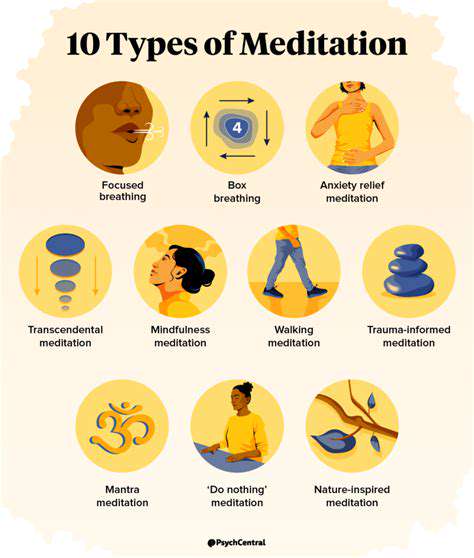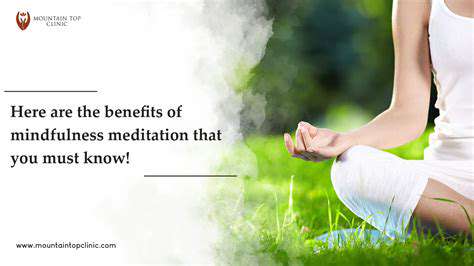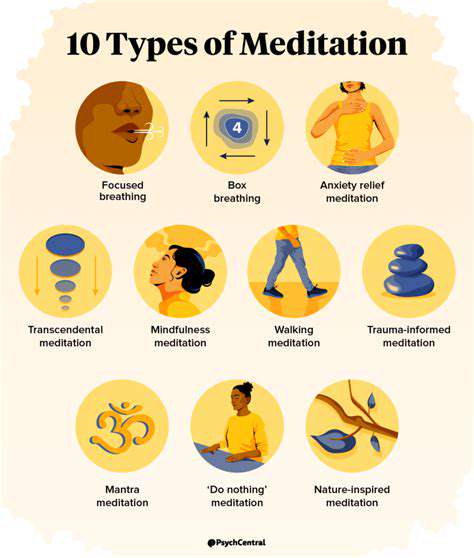Meditation Practices That Boost Mental Health in Everyday Life
The Science Behind Meditation and Mental Health
The Physiological Benefits of Meditation
Meditation has long been associated with various physiological benefits, which contribute significantly to improved mental health. One of the most notable effects is the reduction in levels of the stress hormone cortisol. High cortisol levels are linked to anxiety, depression, and overall mental distress.
Additionally, meditation can lower blood pressure and improve heart rate variability. When the body experiences less stress, it can function more optimally, which indirectly supports better mental health. Lower blood pressure reduces the risk of chronic diseases, allowing the mind to focus on wellness instead of survival.
Neuroscientific studies indicate that regular meditation can lead to structural changes in the brain. Areas responsible for emotion regulation, such as the prefrontal cortex, show increased gray matter density, enhancing one's ability to cope with emotional stress.
Furthermore, practices like mindfulness meditation promote a heightened sense of self-awareness and emotional intelligence. This allows individuals to recognize and navigate their thoughts and feelings more effectively, leading to better emotional regulation.
Finally, the physiological benefits extend to enhanced sleep quality, as meditation helps to calm the nervous system. Improved sleep is critical for mental health, as it influences mood, cognitive function, and overall well-being.
Meditation Techniques for Daily Practice
To incorporate meditation into everyday life, individuals can start with simple techniques that require minimal time commitment. One effective method is focusing on the breath. This practice involves paying attention to the inhalation and exhalation, helping to center the mind and reduce distractions.
A guided meditation is another approach, which often involves listening to a recording that leads the practitioner through a series of mental exercises. This can be particularly beneficial for beginners, as it provides structure and reassurance during practice.
Mindfulness meditation encourages individuals to be present in the moment without judgment. This can be done during routine activities like walking, eating, or even washing dishes. By actively engaging with these everyday moments, individuals can cultivate a deeper sense of awareness and appreciation for life.
For those who enjoy a more active form of meditation, yoga blends physical movement with mindfulness and breath control. It not only supports flexibility and physical health but also promotes mental tranquility and stress relief.
Finally, visualization techniques can be powerful tools for building mental resilience. By picturing a peaceful scene or imagining oneself achieving a goal, individuals can foster a positive mindset and reduce anxiety levels.
Integrating Meditation into a Busy Lifestyle
Incorporating meditation into a busy lifestyle can seem daunting, but it is achievable with a few simple adjustments. Setting aside a specific time each day, even if just for 5-10 minutes, establishes a routine that can help reinforce the practice. Morning is often an ideal time, as it sets a positive tone for the day ahead.
Utilizing small pockets of time throughout the day is another effective strategy. For instance, practicing mindfulness while waiting in line or during a commute can turn otherwise mundane moments into opportunities for mental clarity and relaxation.
Creating a dedicated space for meditation at home can also enhance the experience. This could be a corner of a room with soft lighting, cushions, or calming elements like plants or candles, making it an inviting space to unwind and focus.
Employing technology can assist in maintaining a regular practice. There are numerous meditation apps available that offer guided sessions, reminders, and progress tracking, helping to motivate and sustain one's commitment.
Lastly, connecting with a community or a meditation group can provide additional support and accountability. Sharing experiences and techniques with others fosters a sense of belonging and encourages continued practice.
Types of Meditation That Impact Mental Well-Being

Mindfulness Meditation
Mindfulness meditation is the practice of being fully present in the moment without judgment. This technique encourages individuals to develop a heightened awareness of their thoughts, feelings, and sensations.
By regularly practicing mindfulness, individuals can learn to acknowledge their emotions without becoming overwhelmed by them. This ability can significantly reduce feelings of anxiety and stress.
Transcendental Meditation
Transcendental meditation involves silently repeating a mantra to achieve a state of deep relaxation and mental clarity. This practice is designed to settle the body into profound rest and allow the mind to transcend ordinary thought patterns.
Regular practitioners have reported improvements in overall mental health, including reduced levels of depression and heightened feelings of well-being. Furthermore, it can enhance focus and creativity, making it a valuable tool for both personal and professional life.
Guided Visualization
Guided visualization is a technique where individuals use mental imagery to achieve relaxation and emotional healing. Often led by a guide or a recording, this practice helps to create peaceful and positive mental images.
By engaging in guided visualization regularly, participants can cultivate a more optimistic outlook on life. This practice may also assist in managing stress and enhancing the ability to cope with difficult situations.
Mindfulness Meditation

Understanding Mindfulness Meditation
Mindfulness meditation is a practice that encourages individuals to focus on the present moment without judgment. This technique helps enhance one’s awareness of their thoughts, feelings, and bodily sensations, leading to a greater understanding of oneself.
By regularly engaging in this kind of meditation, practitioners can develop a more compassionate attitude towards themselves. This self-compassion can significantly reduce mental health issues such as anxiety and depression.
Benefits of Incorporating Mindfulness into Daily Life
Integrating mindfulness meditation into daily routines can create positive shifts in mental health. Even a few minutes of mindfulness practice each day can help cultivate a sense of calm and clarity.
Moreover, it can improve focus and emotional resilience, equipping individuals to better handle stressors. This resilience not only benefits mental health but also enhances overall well-being.
Transcendental Meditation
What is Transcendental Meditation?
Transcendental Meditation (TM) is a simple, natural technique that involves silently repeating a specific mantra to promote relaxation and a deep state of restful alertness. Unlike other forms of meditation, TM does not require any effort to control thoughts; instead, it encourages a natural shift in consciousness.
The practice of TM is carried out for about 15 to 20 minutes twice a day, typically while seated comfortably with the eyes closed. This approach allows individuals to settle into a state of deep relaxation and mental clarity, which can lead to numerous mental health benefits.
Originating from ancient Vedic traditions, TM was popularized in the West by Maharishi Mahesh Yogi in the 1960s. It has since gained a large following, celebrated for its simplicity and effectiveness in reducing stress and enhancing overall well-being.
Research has shown that TM can significantly decrease anxiety and depression levels, making it a valuable practice for individuals seeking mental health improvements in their daily lives.
Benefits of Transcendental Meditation for Mental Health
One of the most remarkable benefits of TM is its capacity to reduce stress. Regular practice has been linked to lower cortisol levels, which is a hormone that indicates stress. This reduction can lead to improved mood and greater resilience in facing daily challenges.
In addition to stress reduction, TM has been shown to enhance emotional well-being. Individuals practicing TM often report feelings of greater happiness and satisfaction, with less frequent episodes of anxiety and depression.
Another significant benefit is improved focus and cognitive function. Many practitioners of TM experience increased clarity of thought and better memory retention, which can be particularly beneficial in both personal and professional environments.
Overall, the mental health benefits of TM make it a powerful tool for those looking to enhance their quality of life and achieve a more balanced mental state.
How to Get Started with Transcendental Meditation
Getting started with TM typically involves finding a certified instructor who can provide personalized guidance and instruction. This is an important step, as proper technique is essential for the practice to be effective.
Once you have an instructor, you will be given a personal mantra, which is a specific word or sound that is unique to you. This mantra is crucial for helping you enter a meditative state.
It is recommended to establish a routine by setting aside dedicated time each day for practice. Consistency is key, and finding a peaceful environment can greatly enhance the experience.
As you begin your practice, remember that it is completely normal for thoughts to arise. TM teaches you to gently return to your mantra without judgment, allowing your mind to settle naturally into a deeper state of relaxation.
Incorporating TM into Your Daily Life
Incorporating TM into your daily routine can be incredibly beneficial. Start by selecting a specific time that works best for you, whether it's during the morning to set a positive tone for your day or in the evening to unwind after a busy schedule.
Finding a comfortable and quiet space where you can practice without distractions is also important. This environment will help you focus and fully engage in the practice.
Over time, as you integrate TM into your daily life, you may notice that you handle stress more effectively and approach challenges with a clearer mindset. This can have a positive ripple effect on your relationships and work life.
Ultimately, the goal of TM is not just to meditate but to cultivate a greater sense of awareness and peace that you carry with you throughout your daily activities, enhancing your overall mental health and well-being.
Loving-Kindness Meditation
Understanding Loving-Kindness Meditation
Loving-kindness meditation, or "Metta" meditation, is a practice that focuses on developing an attitude of love and kindness towards oneself and others. It involves silently repeating phrases that express good wishes for oneself and for others. This form of meditation can foster compassion, empathy, and emotional resilience.
Typically, practitioners begin by cultivating feelings of compassion for themselves. After establishing this positive feeling, they gradually extend these thoughts to loved ones, acquaintances, and even those with whom they may have difficulties. This expansion of goodwill can significantly enhance social connections and emotional health.
The practice can also serve as a powerful antidote to negative emotions, such as anger and resentment. By consciously wishing for the happiness and wellbeing of others, individuals can create a more nurturing internal environment, leading to improved overall mental health and a more positive outlook on life.
Benefits of Loving-Kindness Meditation
One of the primary benefits of loving-kindness meditation is its ability to reduce stress. Research has shown that regularly engaging in this practice can lower levels of anxiety and cortisol, the body’s stress hormone. This reduction in stress can enhance feelings of calmness and stability in daily life.
Additionally, loving-kindness meditation can improve emotional health by fostering positive emotions. Studies indicate that those who practice this form of meditation experience greater feelings of joy, gratitude, and inspiration. This shift towards positivity can have lasting effects on mental well-being.
Moreover, this meditation practice positively impacts social connections. Practitioners often report feeling more connected to others and more engaged in their communities. This sense of connection can further contribute to overall happiness and provide a solid support system in challenging times.
How to Practice Loving-Kindness Meditation
To begin loving-kindness meditation, find a quiet place and sit comfortably with your eyes closed. Take a few moments to focus on your breath and settle your mind. Once you feel calm, start by silently repeating phrases that wish goodwill towards yourself, such as "May I be happy, may I be healthy, may I be safe."
After a few minutes, gradually extend these well-wishes to someone you care about, then to a neutral person, and finally to someone you may have difficulties with. This gradual expansion helps to cultivate feelings of love and compassion for all beings, promoting a broader sense of empathy.
It’s important to practice consistently, even for just a few minutes each day. Over time, the practice can become a natural part of your daily routine, creating a more compassionate mindset that enhances your interactions and emotional wellbeing.
Incorporating Loving-Kindness Meditation into Daily Life
Incorporating loving-kindness meditation into your daily routine can be as simple as setting aside a few minutes each morning or evening. You can also practice it during moments of stress or when you’re feeling negative emotions. By consciously directing loving-kindness towards yourself and others during these times, you can transform your emotional state and improve your reactions to challenging situations.
Another effective way to integrate this practice is through journaling. Writing down phrases of loving-kindness or reflecting on positive experiences can deepen your understanding and commitment to the practice. This can also be a way to track your emotional journey and recognize shifts in your mindset over time.
Finally, consider joining a meditation group or class to explore loving-kindness meditation in a community setting. Being part of a group can enhance motivation and provide support as you cultivate a more compassionate and connected approach to life.
Incorporating Meditation into Daily Life

Understanding the Basics of Meditation
Meditation is a practice that encourages an enhanced state of awareness and focused attention. By regularly practicing meditation, individuals can cultivate mindfulness and reduce stress levels.
There are many forms of meditation, including mindfulness, transcendental, and loving-kindness, each serving different purposes and appealing to varied preferences. Exploring these types can help you find the right one that fits seamlessly into your daily routine.
Setting Up a Dedicated Meditation Space
Creating a tranquil space for meditation at home can significantly enhance your practice. A designated area can help you develop consistency, making it easier to engage in meditation daily. Your meditation space should be quiet, comfortable, and free from distractions.
Consider adding calming elements such as soft lighting, comfortable seating, or plants that contribute to the ambiance. The goal is to create an environment that invites peace and encourages relaxation.
Integrating Meditation into Your Routine
To incorporate meditation into your daily life, start small with just a few minutes each day. Gradually increase the duration as you become more comfortable with the practice. Consistency is key; aim to meditate at the same time every day to form a habit.
You can also integrate mindfulness moments throughout your day, such as mindful breathing during breaks or while commuting. Engaging in these practices can help reinforce the benefits of meditation and deepen your connection to the present moment.
Tracking Your Progress and Benefits
Keeping a meditation journal can be a valuable tool for tracking your progress and reflecting on your experiences. Documenting your feelings before and after each session can help you understand the benefits over time. Regular reflection fosters a deeper appreciation for how meditation positively impacts your mental health.





